Welcome back to another Fitting Fundamentals article! This one will be very much in the vein of a few other articles that I’ve written and if you enjoy this then I recommend checking out Fitting Fundamentals: PvE Fits. Another article which takes a look a the PvP fit design process is How 2 Fit. PvP and PvE fitting are considerably different from one another so make sure you brush up on both.
As before, this is an article to complement my EVE Uni lecture. I’ll link that here once the recording is available, though you might find that it’s a bit scatterbrained and over two hours long. This is a big topic after all.
I’ll be skipping the preamble from my PvE article around Pyfa and why you might want to learn how to fit. If you already have Pyfa and know how to use it then that’s great, if not then pop over to the PvE article for a few minutes and have a read. As before, you may also use EVE Uni’s lexicon to brush up on any unfamiliar terms that I use here.
Initial Considerations
Alright, this is a big topic (surprisingly). I often get asked “Ashy can you make me a fit for x?” and it’s an impossible task for me unless they can answer my next question which is “Well what do you want to do with it?” This is because you can fit a ship for any purpose you like in EVE Online. A Thrasher might make a terrible logistics ship, but you could still technically optimise a fit to do just that for some reason. Knowing what singular purpose you want that ship to perform is a huge part of hull choice and with how you move forward from there.
A great example of this is that you’re after a new, cheap kiting ship under 100m ISK in the cruiser category. In this situation it narrows down your hull choice to the following key aspects to pick out and base the fit around:
- Must be relatively fast (or have enough other qualities to make it worth using more speed mods).
- Must shoot to 20-30km minimum.
- Must deal 350-400 DPS minimum (to make it worth using a cruiser at all and not just a nimble frigate).
Those qualities don’t exactly narrow down your options a huge amount, but you can start to eliminate super slow ships such as the Maller or expensive ones like the Orthrus. We can refine things further by adding in more ideals for what you want your fit to do. If missiles are what you want to use then the Osprey Navy Issue or Scythe Fleet Issue might come to mind. If you need to be cloaky then it limits you to any T3, a Force Recon, or – to stay closer to your budget – a Stratios.
This concept can be used at any point in the fitting process where you need to be asking yourself “how does this module help me against x, y, or z?”. Some sample questions are on my slide above, but here are some of the ones I tend to ask myself quite often. You can determine the answers to these questions by making quick test fits in Pyfa of one statistic such as filling a ship with guns, drones, and 3-4 damage mods to test DPS. Pyfa’s compare tool is also fantastic!
- What is the max DPS/tank/speed/agility of my ship (and others in the class) and how does that compare to what I am fitting now?
- How much does this cost? How much value am I getting out of this module vs another?
- I need a fitting rig, can I regain that rig slot by swapping modules around?

A PvP Fitting Process
Moving onto the process of fitting itself now and it isn’t quite as simple as the PvE method of Important Utility + Guns > Tank > Capacitor > DPS. We’ve now got many more considerations to make with regards to other players, how they’ll behave, what they’re flying, and who they have to back them up. We’ve also got two ‘routes’ to take for either fleet or solo PvP design.
Take your initial considerations into account at each step of the way here and always think about the intended outcome and how you can best approach that. If you aren’t sure then make two or three tests and compare each. My Fit Kitchen articles often go through 20+ discarded fits even if I’m only showcasing five.

Solo Fitting
- When you’re fitting up a solo PvP ship, the first thing you want to consider is how you intend to fly the ship. Do you want to get up in someone’s face and brawl them, do you want to keep safely at range and kite them, or do you want a mix of both that’s more about getting in and out fast? The latter is what I would call skirmishing and is akin to flying something like a Stabber Fleet Issue or nano Drekavac.
- Once you know how you want to engage other players, you can now put the prop mod on. It’s an important choice to make early since it will affect how the ship handles in combat and will often be a big part of your fitting costs in powergrid and CPU. Remember that you can always fit two different ones, too. Dual prop setups have their place and MWD+MJD is hella fun for catching people off-guard.
- Focus on DPS now. Get the guns on and your damage/weapon range mods. You need to do this now to ensure that your ship isn’t caught out with no DPS. Having good damage will make killing your opponent faster and much much easier.
- Tackle and important utility should be fitted now. By that, I mean your point or your scram+web. These are another essential part to PvP and without them you can expect your opponent to simply warp away. You might also consider fitting something like dual medium neuts at this point if it is important to your planned style of flying.
- Finish up by fitting the tank – as much as you can get with capacitor as a secondary concern unless you are actively tanked.
- Now the hard part. Review it! Take the final fit and compare it to the maximum potential it could reach in any one area or to someone else’s fit. Is yours better at something? Why/why not?
Each of the above ‘steps’ can be placed in a different order depending on the priority. Obviously, I’ve listed tank last since it’s foolproof to do it that way, but you could instead focus and almost tunnel-vision onto tank if you needed to. You might do this in a specific situation where you want to hold tackle or where you need to act as bait.

Fleet Fitting
Fleet fit design is a bit different in that you need to now be focusing a bit more on survival and on price. Note that this is not the same as a nanogang necessarily. When I say fleet I am talking more about a cohesive doctrine that will fly together and most likely has logi to repair each other.
- Step one in this case is to examine the wealth and skills of your fleet members. This is very important since keeping costs down and picking the right hull will resolve two problems: A doctrine too expensive to risk losing so nobody gets to have fun / A doctrine that nobody can fly because you’re asking newbros to fly Command Ships or something.
- Prop mod comes next once again and I really can’t stress how important the prop is on a PvP ship. In a fleet you’re going to look to homogenise the speeds of everyone. There’s no use in having half the fleet zoom off to safety with MWDs while 5-10 people get left behind to die thank to their afterburners.
- Tank is now more important, fit this next. Stay away from active tank fits and aim for buffer with good resists. Better resists will help you to hold under logi reps, but you still need to attain that minimum level of buffer which means you don’t get alpha’d (one-shot) through to hull. Knowing that level of required buffer comes from experience and from thinking about who you expect to fight. Fighting against ten average cruisers will probably see you chunked for 45-50k EHP within the first 7 seconds for example.
- Damage and application now. It’s definitely very important, but the focus is typically on survival. The longer you can stay on grid, the more time you have to wear away at your opponents. Just make sure the DPS isn’t anaemic or it might be worth reconsidering the hull choice.
- Tackle and utility can come last most of the time. Tackle especially is a little less important in a fleet scenario since you have so many fleet members to potentially hold tackle on a target. In my Drekavac fleets, I tend to use singular points/scrams/webs across the fleet. This means that 1-2 people might have no ability to stop a warp alone, but they are crucial to the operation of the entire fleet in holding someone still.
- As before with solo fits, you can now review and compare to other ships and fits!
Working With or Against Bonuses
Considering that fitting choice and on-grid behaviour in PvP is based on expectations, you’ve got another huge tool in your arsenal. And it’s one that I would say can win you 90% of the fights you take. It’s being unpredictable.
Think about it this way with an obvious example. The Huginn is a long-range web ship that wants to stay FAR away and web you from 60km+ for its fleet. Getting right up on top of it would be very beneficial and help you kill it, right? What do you do when you get on top of it and it scrams and webs you with 800 DPS applied? You’re now 45km away from your friendly fleet and you fell for a trap which might get you killed.
The same thinking can be taken with nearly any ship in the game so long as you think about what it usually does. It’s all about telegraphing a story to other pilots who may be watching and then betraying that at the last minute to spring your trap and catch people in an unfavourable position. This thinking should begin in the fitting process and I wanted to bring this up primarily because it will often explain the ‘weird’ fits you see floating about.
Another example of a bait style I enjoy is a hull tanked battleship that uses ancillary shield boosters. The idea is that you appear to simply have a really poor tank and are slowly breaking. It keeps people on grid longer and is more effective than the standard bait hull tank where damage slows right down in hull. Again, this thinking is baked in right from the start and I encourage you to take a keen eye to fits and to see if they are playing to a hull’s bonuses or if they are doing something weird.
Knowing Your Opponents
I debated with myself whether this was worth an entire section or if you can consider this to be a part of the initial considerations that you make when choosing the hull. Really though, knowing your opponents and how you plan on dealing with them is another huge part of how you should steer the fitting process.
Take a look at the EVE Uni slide I prepared above which discusses this topic. I left it intentionally blank to give people time to think for themselves about how they might tackle each of these threats and what each one would do to their fit or fleet. If you don’t want spoilers then click on the image and have a read before you check out my bullet points below:
- Orthrus – Fast, kitey ship with long point, long scram, and likely light missiles. This can be very scary for a solo player. It can be forced off by long-range weapons, an extremely fast and agile ship to slingshot him very well, long webs, or simply EC-300 drones in a pinch.
- Kitsune – Strong ECM jamming frigate that sits at 90km. This is more of a danger to a fleet. If you are facing one of these in a solo situation then just leave (or die). It could be countered by planning ahead with a beam Legion or a friendly ship in a fast combat interceptor buzzing around.
- Brutix – Typically a big armour or hull tank and 1,000 blaster DPS. Preparing for this isn’t always so important but you could fit neuts to reduce incoming damage from their blasters or specifically tank against kinetic and thermal.
- Tornado – Very similar situation to the Kitsune except with high alpha damage instead of jams. Again, you might prepare with a Beam Legion slotted into the fleet. In a solo situation, you might prepare with your own micro jump drive.
- Malediction – Fast bubble immune interceptor that can hold tackle very well. Similar to the Orthrus, except much more easily chased off by light missiles or drones… as long as they are fast enough. Remember that there are rigs which will make missiles fly faster and some drone choices are faster than others!
The next question you might ask is “how will I know what ships I will face?” There isn’t really an easy answer for that, unfortunately. It can be made simple in certain situations such as a lowsec plex where ship options are limited or by looking at the popularity of ships, but it really does all come down to experience.
You get that experience by making mistakes and being caught without the tools you need to win the fight. That’s part of why the age-old advice of losing 10-20 frigates in PvP is so useful, not only in combat but in the theory crafting too.

Tank and Weapon Choice
Now, I really would suggest reading up on the weapon systems and tank types in EVE on EVE Uni rather than directly here. It’s where I originally started and they have some very good material that goes right down to the turret tracking formula. Besides, the last time I discussed maths and formulas nobody read it.
Instead, here are a few of the more frequently asked questions that people ask about fitting in PvP. You can browse the lecture slides below if you like, too. If you like this style of writing then check out the common advice section of How 2 Fit.
When should I fit polarised weapons?
The answer to this is if you have a ship that can reach an ‘ok’ amount of EHP while pumping out silly amounts of DPS. Always compare such a ship to the non-polarised version and determine if the EHP loss is worth the DPS and tracking gain. A good example would be the polarised Cynabal which can reach about 20k EHP and 1,000 DPS or the Exequror Navy Issue with similar EHP and 1,600 DPS.
How many of each rep should I have in an active tank?
This is something I see newbros often run into problems with. Generally, one shield booster or two armour reps is standard. Triple rep armour does exist and so do dual/triple XLASB fits, but they are niche and need the entire fit building to suit them. This is due to the capacitor requirements of the different repair modules and how they are balanced.
When do I use ancillary reps?
Ancil reps are what I would consider to be ‘active buffer’. That is that they provide a set amount of EHP over about 30 seconds by burning through 8 or 9 charges of nanite paste or cap boosters. Fitting these will nearly always give you a big bonus to tank but will limit the time you can tank it for severely and you need to weigh up if that’s useful. 1x normal and 1x ancillary armour rep is quite standard, however, since ancillary armour reps can be run without paste for reduced performance. Ancillary shield boosters, however, will just eat all your capacitor in one shot once empty of boosters.
Which size of weapon do I use?
Use the biggest possible within the weapon class (e.g. medium autocannons) unless you need to make them smaller for fitting purposes or to increase your tracking at the cost of range and DPS. As a general rule, autocannons will go down in size quite easily whereas lasers and blasters will quickly lose stats so try to avoid it with them. The same is true with long-range weapons except 650mm artillery is trash.
Aren’t missiles just the best with their range and damage?
Missiles are easy to use and can appear to have great damage and range, but they will significantly suffer if you don’t have missile guidance computers, webs, or paints and you’re trying to shoot something small. They also have a travel time, meaning long-range missiles will give your opponent advance warning to rep the target.
How much tank/DPS/speed is good?
What makes any ship good is going to be a difficult thing to describe and it comes mostly from experience and staring at these DPS or tank numbers every day. A ‘good’ destroyer, for example, would have 9-10k EHP, 6-800 DPS, and 2km/s+ speed. You’re not always going to get each of those stats on a ship so instead it’s a case of making those test fits and playing with the tank figures until you know what good looks like in each category.
Lecture Tank & Weapon Slides
Ammo Choice
Ammo choice is another important thing to consider during the fitting process. You are going to be putting the ammo into your fits, aren’t you? The main thing I want to highlight here is a set of fantastic graphs that were released a while ago by Ra’zok Zateki from Novac. I haven’t asked for permission to post these here, but they were released on Reddit a while ago and I want to give them more visibility.
Additionally, here are some generic tips on picking the right ammo for each weapon. The non-bold wording refers to the correct faction choice to make. Always use faction or T2 ammo, T1 ammo is hardly worth it. For capitals, you should take the faction one step down such as from Republic Fleet to Arch Angel due to pricing.
It’s also worth knowing that the way T2 ammo works is that they will usually offer a version which takes the weapon to its max performance at the designed range, and one which makes it behave like the other weapon system. Railguns can either reduce their tracking but shoot to really silly ranges with Spike, or they can load Javelin and have closer performance to Blasters with better tracking.
- Projectiles – Republic Fleet
– 3-4,000 of one or two of the high-damage ammo choices (Phased Plasma, EMP, Fusion)
– 1,500 high tracking ammo (Titanium Sabot or Depleted Uranium)
– 5,000 of each T2 ammo (Hail and Barrage or Quake and Tremor)
You can afford to bring less of each for artillery since it fires so slowly. Arty can also benefit from Domination ammo for a 5% damage boost. It’s expensive, but the slow firing can make it worth using sometimes.
- Hybrids – Federation Navy or Caldari Navy
– 3-4,000 Antimatter
– 5,000 of each T2 ammo (Void and Null or Javelin and Spike)
– Railguns should pick a few of the others too based on potential range. Test this in Pyfa.
- Lasers – Imperial Navy
– number of turrets = n
– n Multifrequency
– 2*n of each T2 ammo (Conflagration and Scorch or Gleam or Aurora)
– Same as railguns. Pick a 2-3 more crystal sets based on ranges you expect to be fighting at. Also, Scorch is amazing.
- Missiles – Caldari Navy
– Pick any damage types that you feel will be useful and load a few thousand of each. Load some mixed T2 ammo as well and try not to leave any gaps in damage types you can fire.
Having all 12 missile types for each launcher will be stressful in combat and make picking the right one hard.
- Disintegrators
– 650-1,000 of each ammo type including T2. A magazine holds 500 and will fire for about 25-30 minutes.

Final Words
To close this out I’d like to include the images from the last few slides from my lecture. They’re relatively self-explanatory since they describe themselves. The idea is that I was trying to point out all the different things that I am looking at when I see a fit. This is the kind of criticism you should take to your own fittings.
The three images are:
– An old Caracal Navy Issue I found in a structure somewhere. Discussed in Fixing Fits.
– My old Shield Skirmish Hurricane Fleet Issue that I would do a bit differently these days.
– My current Heavy Armour neut+DPS Legion fit.
If you’ve found this helpful then I’d love to hear from you. Likewise, if you haven’t or if something was confusing. Let me know in the comments and I can get it updated for everyone else too. I’d also recommend reading my other articles if you’re new here. Read what I say about fits; I like to explain why I fit things certain ways rather than just throwing a bunch of fits at people.
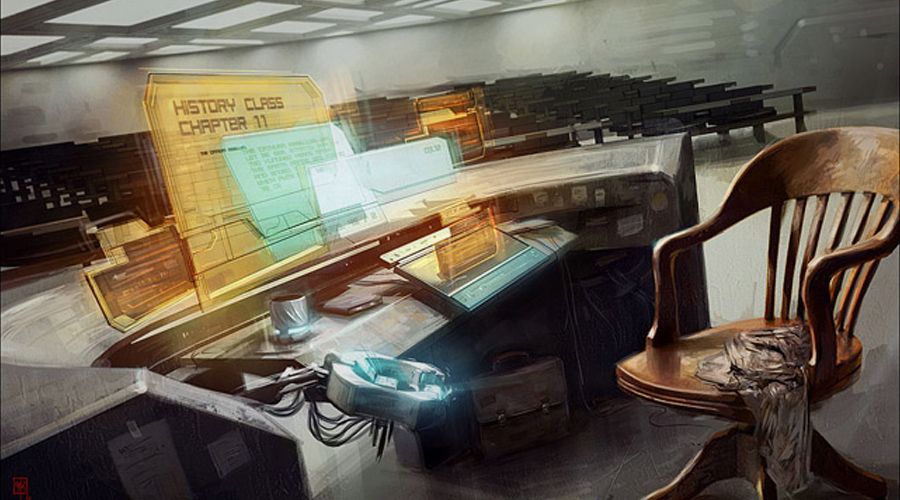


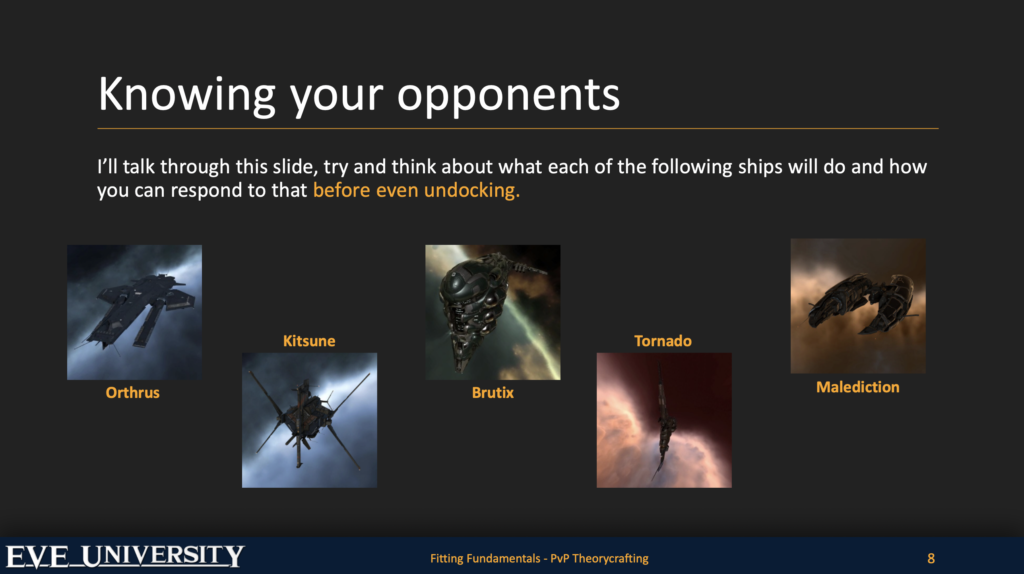









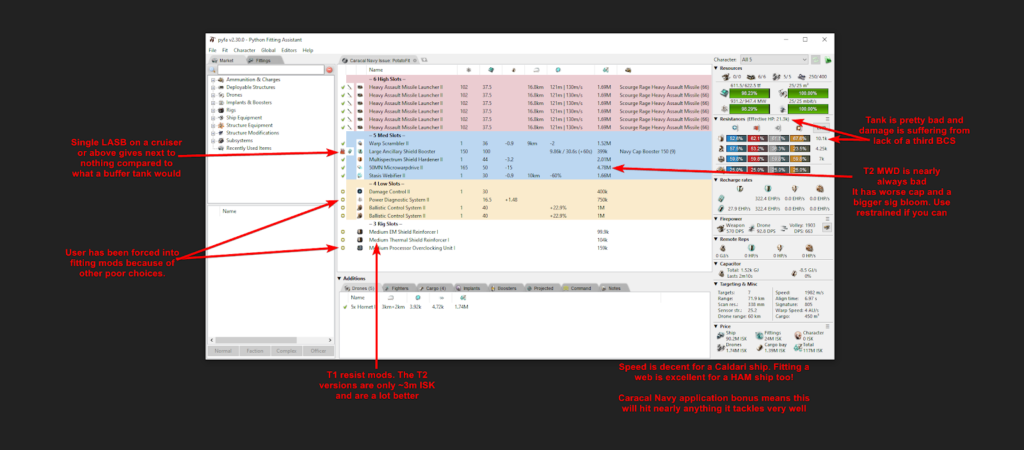
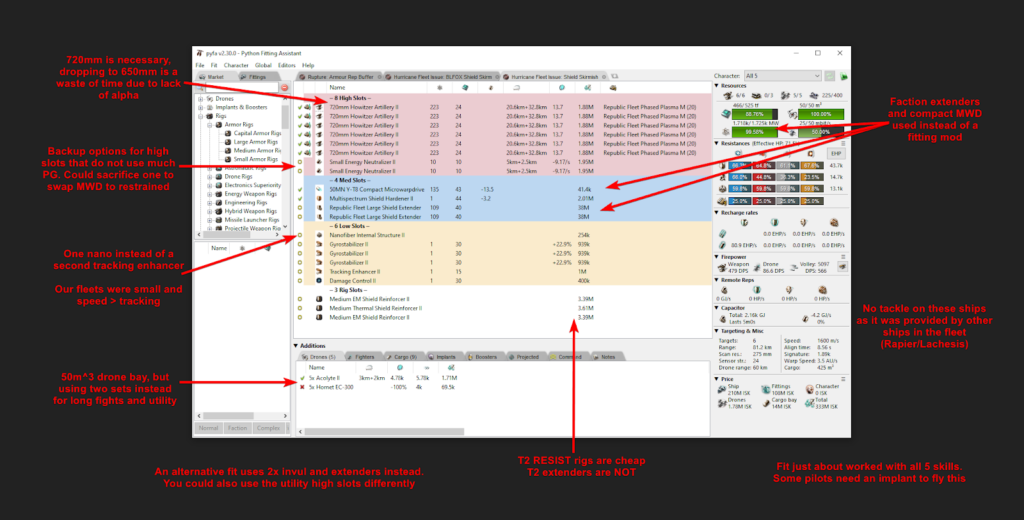
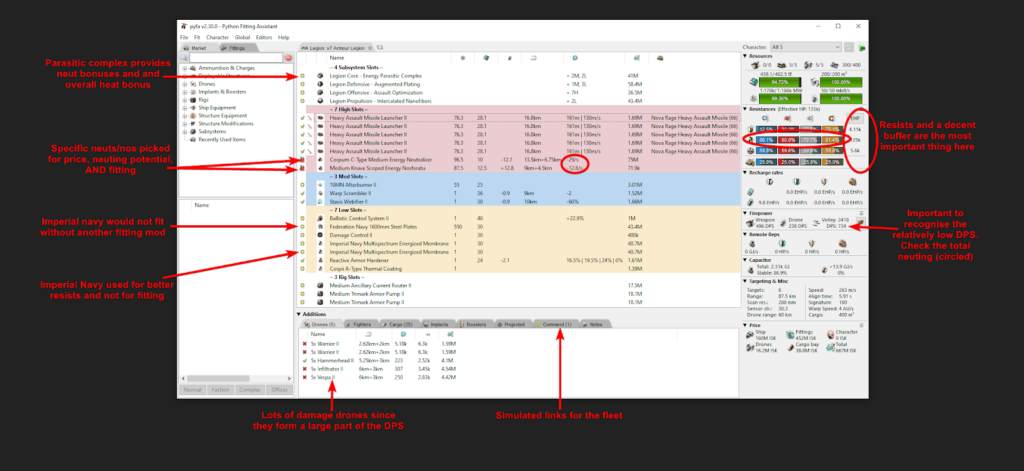
[…] Fitting Fundamentals: PvP Fits » Ashy in Space […]